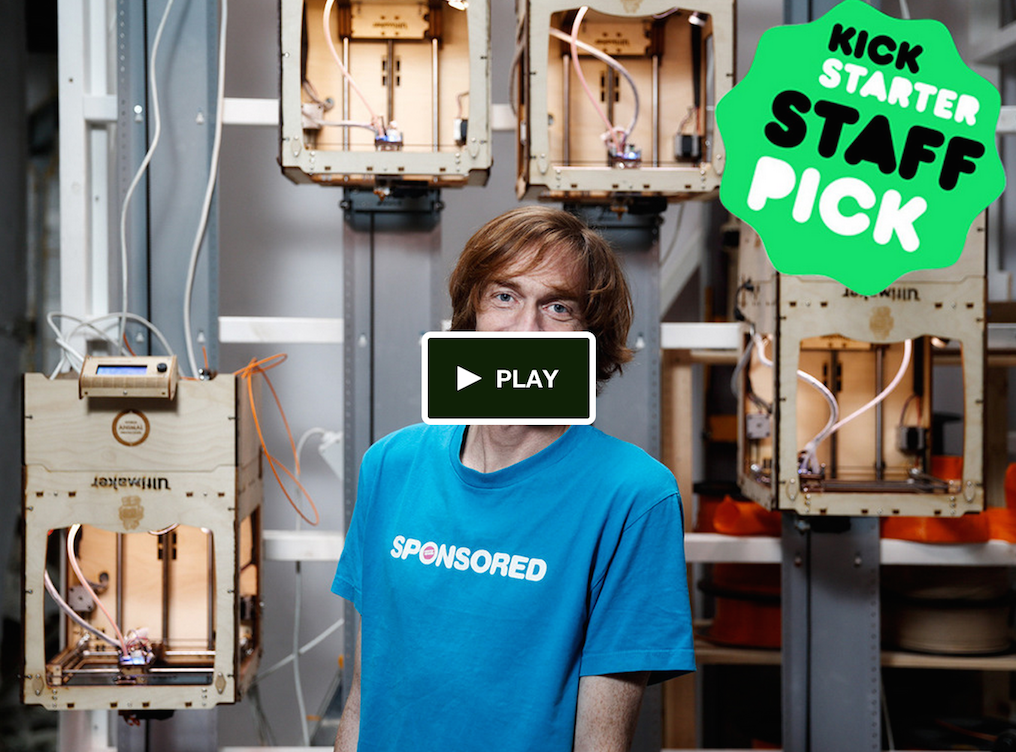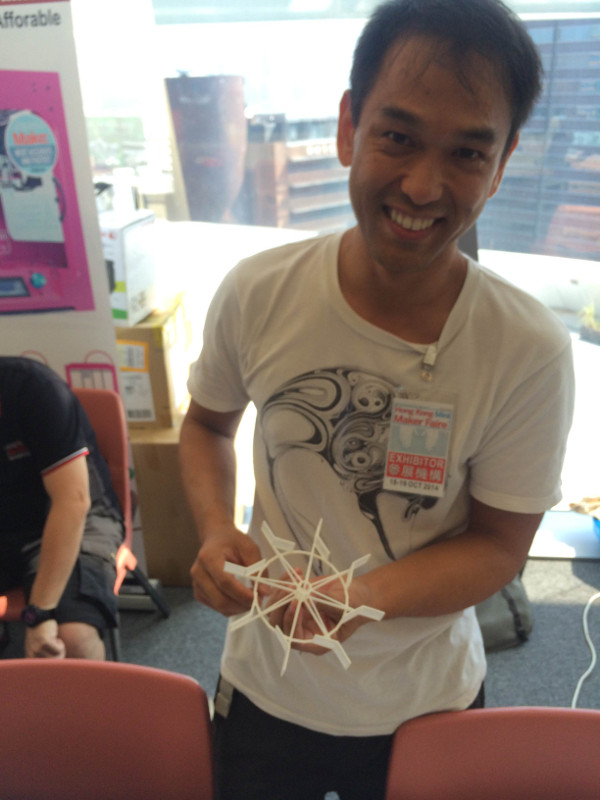I’m interviewing members of our community to find out what kind of things they make, how they make them and why they make. If you have a suggestion as to someone you’d like interviewed or have a project you’d like to get others involved in please email joris at youmagine.com. Chris Payne is Cpayne3D on YouMagine, his Single Bat ATSC Digital HD TV antenna caught my attention and I reached out to him to find out more about it.

Chris & his Single Bay ATSC HD TV Antenna
Why and when did you get involved with 3D printing?
Around three years ago a friend of mine was flying an R/C multi-rotor aircraft in a park near where I live. I fly R/C electric planes so I was very curious about this. I asked where he purchased the multi-rotor and he began to tell me that he printed it on a 3D printer that he built. I knew instantly that I had to build one of these 3D printing machines.
Why did you need a 3D printer?
I have always been a tinkerer and have so many different hobbies. My hobbies generally require that I custom build parts and jigs, that I would normally create out of wood, plexiglass-plastic or metal. Now there was a way to create more complex parts without glue or screws.
What were some of the difficulties when you started?
The 3D printing phenomena has many challenges. Every step of the process seems to have a road block or two that could put a person off of getting involved.
At the start of my journey, I found printer designs on the internet that were comprised of nearly 50%, 3D printed parts. You couldn’t make a printer unless you already had a printer. This was a sobering thought for me. My friend who I recently discovered had a Mendel 3D printer gladly produced parts for the original MendelMax that I could build. It took a lot of time to print these parts, which was another revelation for me. After receiving the printed parts and sourcing the vitamins from local industrial suppliers, I was beleaguered one more time. The additional parts proved to be hard to source and also were expensive unless bought in bulk. In the end my MendelMax had issues due to imperfect smooth rods. I nearly gave up at that point.
My friend then showed me a web site that was selling kits made with makerslide aluminum rail. It looked professional, and there were no smooth rods. I ordered the mechanical platform kit (minus the electronics). A couple of weeks later the parts arrived undamaged. This is the kit that I am running to this day, although I have exchanged the extruder and hot end several times until a fool proof configuration was built.
In 2015, the marketplace in for 3D printer vendors has improved tremendously. The machines are available everywhere, and even at retail stores where you wouldn’t expect to find prebuilt 3D printers. What a difference a few years can make for this technology.
What tools do you use to design?
I use a combination of tools to create my designs. It all depends on whether I have the foresight to post the parts online or not. Any part or project that I intend to share online will be create in OpenSCad. This way the one who downloads the files can make alterations if necessary. Otherwise I may prototype a part very quickly using TurboCad 8 for MAC. I only have MAC computers at home, so this tool works very well.
What kind of things do you make?
I am very hobby driven, and I am always trying to solve every day problems. It is safe to say that I make things that other people may not make. I have quite a list of upgrade parts that I have created for 3D printers, repair parts for things that break around the house, a really great LCD controller housing for 3D printers, and finally a 3D printed implementation of an “over the air” UHF HD TV antenna.
Why an antenna?
A couple of years ago I had been keeping an eye on the North American transition of the over the air television broadcast from analogue to digital format. When the conversion deadline occurred in Canada, I decided to research the UHF information online. I discovered a long range UHF antenna element design created by Doyt Hoverman (born 1913) of the USA. This was very coincidental as his design was put into the public domain under the GPL license a few years earlier. I built an antenna using the Hoverman element with a home built wooden frame. I then installed the antenna into the attic at my home (all 20 lbs of it) and it worked great.
Since then I had the idea to make the HD TV antenna lighter and easier to build. And quite a few people that I had spoken to since the 2008 economy crash reluctantly had to cancel their cable or satellite subscriptions out of necessity. This was not lost on me.
I found myself with some vacation time, and that was all that I needed to initiate a rough design for a 3D printable TV antenna in OpenSCAD. I challenged myself with two goals:
1 – build a lighter antenna to replace the heavy one in my attic
2 – build an antenna, with a minimal number of fasteners that anyone could build. Inexpensively.
You’ve built on top of other people’s projects. Who and why?
I have designed this printable antenna to accept the existing wire element designed by Doyt Hoverman. The element has proven to function very well, and it is simple to make without any complicate tools. Also, the element shape can be made from new or recycled aluminum material that you may have on hand. It was important to keep to the primary goals to make sharing of this antenna doable.
What can I do with the antenna?
Anybody who has access to a 3D printer will be able to print the parts in less than 9 hours. Assembly is very simple and required only screws and a screwdriver. Install this antenna in your attic, or outdoors in an area protected from high winds and it will receive UHF television broadcasts from ground based transmitters ranging from Channel 2 to 69. You can connect the antenna to an HD TV equipped with a digital tuner, or to a digital tuner box or USB tuner on a computer or laptop. This antenna can be provisioned with a rotor to make it tuneable to receive even more channels. I should also note that it is incapable of picking up satellite transmissions, as this is a question that I often get asked.
What should I pay attention to when making this?
The project prints very well, no supports required. However, here are some things to keep in mind before you start printing:
- Print with ABS filament.
- No need for a raft.
- Any warping of your prints will not affect the assembly.
- Ensure that your first layer adheres properly to the print bed, or the base block may break free of the bed during printing. I print ABS on blue painters tape with the bed heated to 110c.
- Ensure that your printer is able to successfully print short bridging spans (~ 6mm).
Print the “BOLT & Nut” test strip first. It takes 19 minutes to print but it will ensure that your fasteners fit properly before you invest the time to make all of the parts.
- Edit the SCAD file and set up your custom fastener measurements. It will accommodate your selected fasteners!
- The [OUPUT = variable] allows you to choose which parts to export for printing.
Tips for selecting screw lengths before printing:
Here is a safe method for selecting the long screws.
- Select the pole to mount your antenna. (eg: 1 inch, or 25.4 mm PVC).
- Take note of the default fastener length for the printed parts (1.5 inches, or 38mm)
- Add the two measurements:
1 inch + 1.5 inches = 2.5 inches (25.4 mm + 38 mm = 63.4 mm).
In this example the fastener length required is 2.5 inches, or ~63mm.
I really hope that people do find this project beneficial. It is very exciting to be able to create and share 3D printed objects that have a real world impact. To date, this antenna has been downloaded by users from USA, Canada, Argentina, Brazil, Chile, and all over Europe. It is great to be able to witness just how easy it is to make a difference in the world through 3D printing.



















